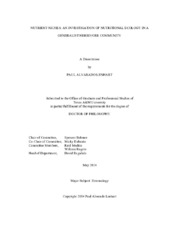| dc.description.abstract | Understanding how diversity is maintained is a classic question in ecology. A
diverse group of organisms can often be found utilizing the same resource. For example,
in grasslands there are communities of grasshoppers containing many generalist species
with overlapping diets that are likely competing for resources. To explore how species
that overlap in host plant use can coexist, I investigated a recent hypothesis in nutritional
ecology that species-specific macronutrient requirements in generalist insect herbivores
could represent different nutrient niches. As a model system I used a community of
grasshoppers in Central Texas.
First, I surveyed variation in plant macronutrient content and compared this data
to the grasshopper community. By assaying levels of digestible protein and carbohydrate
in abundant forbs and grasses at different sites, I produced a ‘nutrient landscape’
available to foraging herbivores and found significant correlations between plant
nutrients and grasshopper abundance.
To further explore the role of plant macronutrient shifts in controlling
grasshopper populations, I manipulated water availability in plots of grassland during a
severe drought. Total grasshopper density and diversity were lower in water-stressed
plots despite previous observations of drought-induced outbreaks. The effect of water
stressed plants on grasshoppers depended on their diet, and how different plant groups
responded to water stress.
I then compared host plant use to macronutrient requirements among 11
dominant grasshopper species. I found differences associated with functional diet
groupings. I also found intake differences among mixed-feeders with highly overlapping
diets, which could potentially represent nutrient niches.
Finally, I tested the nutrient niche hypothesis in a greenhouse competition
experiment using three species of generalist grasshoppers with overlapping diets. I found
mixed support for the nutrient niche hypothesis. Body size was more important for
predicting competitive outcomes.
Understanding community-wide patterns of nutrient regulation in insect
herbivores is in its infancy. While the plant nutrient landscape plays a large role in
consumer populations, we are far from understanding how species-specific nutrient
regulation differences might impact communities. Perhaps the potential effects of
nutrient intake differences are inconsequential next to other ecological factors. Future
comparative studies should determine what evolutionary factors shape nutrient
requirements. | en |


